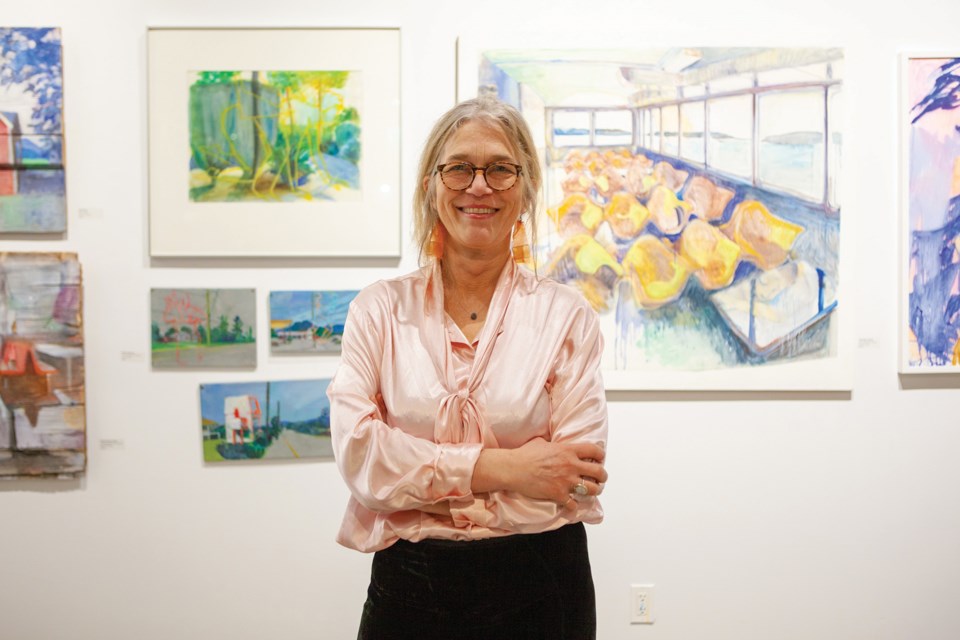A new showcase of artwork at The Kube gallery in Gibsons features a career painter whose probing of people’s inner worlds is expressed through vivid landscapes in which human beings appear sparingly, if at all.
Stefanie Denz’s exhibition Being Whereabouts is her first on the Sunshine Coast. Denz travelled from her Salt Spring Island studio for a public reception at The Kube on March 3.
Over a three-decade career, Denz has shown her paintings in Germany, New Zealand, and across North America. In 2019 she also became an accredited art therapist.
The tranquil landscapes and rural studies on display at The Kube depict places charged with emotional significance for Denz, in contrast to an earlier series of works inspired by the social commentary of filmmakers Rainer Werner Fassbinder and Federico Fellini.
Whereabouts considers the relationship between transitory human beings and the enduring places they inhabit, whether an evergreen grove (Blue Forest Edge) or a ferry lounge (Passenger Seating).
“The thing about going outside is that it comes from a desire to integrate [landscapes] into my own life,” said Denz, “and coming to terms with things that are huge influences in our lives. I just love it at dusk, when the trees almost take on a presence. They merge into that liminal space where things are not what you think you see.”
With unhurried study, Denz’s paintings reveal layers invisible to perfunctory viewing. The broad brushstrokes of Nuria in the Branches, nominally an azure-shadowed glade against a coral sky, gradually admit the shapes of human figures among a confusion of trunks.
In other paintings, like At Finnerty Gardens (inspired by public woodlands at the University of Victoria), Denz uses a distinctive technique to suggest the evanescence of people. Two bodies — one standing, one crawling — are outlined in amber on clear mylar atop the dreamy landscape. Viewers can lift the transparent sheet to erase the human presence.
Her oil-on-metal painting Barb at Winnie’s uses the same technique to depict the treed avenue where she grew up. Sketched on mylar against the background of the suburban streetscape, a claret-coloured matriarch summons her children, at once substantial and incorporeal.
Denz uses a variety of substrates, including rough-hewn wooden surfaces. She builds irregularly-shaped assemblages that protrude in three dimensions. The texture absorbs the oil paint, muting colours and revealing the zigzags of woodgrain.
“I was inspired by [religious] icons,” said Denz. “People worship icons, and that’s how I felt about my painting. I worship the process. Also, what the wood does is disrupt ideas. I have an idea and it interrupts it. As human beings, we have all kinds of conjectures and whatnot, and wood is a little reminder of reality.”
In Bowen Queen Lounge, which pictures the interior of the eponymous coastal ferry vessel built in 1965, knots and cracks form harmonies with the painted scene. An indistinct figure reclines in the foreground, both witness and fleeting protagonist of the image’s earthy nostalgia.
“You follow the direction of the substrate,” Denz added. “When I’m painting on Duralar [a type of polyester film], it’s very smooth and the paint drips. That adds that essential element of not being able to control everything.”
Stefanie Denz’s Being Whereabouts: Presence in local landscapes remains on display at The Kube gallery until March 31. Browse to thekube.ca for details.





